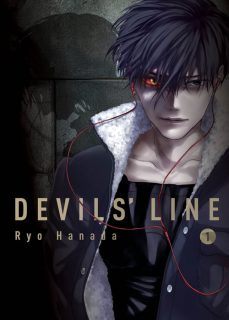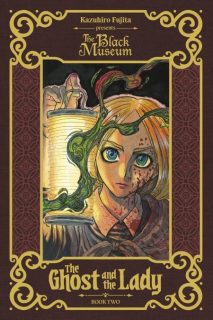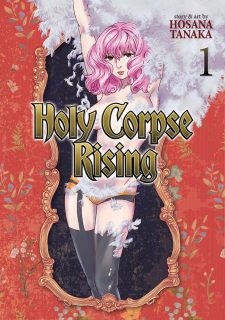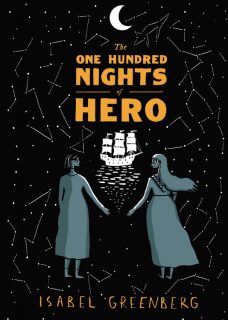My News and Reviews
Last week at Experiments in Manga I posted the Bookshelf Overload for December. It includes a pretty big list of things, in part due to massive holiday sales, so hopefully future months won’t be quite as ridiculous. Another thing that happened last week that was kind of cool was related to a post that I wrote back in 2014. My Spotlight on Masaichi Mukaide is probably one of the most noteworthy things that I’ve ever written and it actually got quite a bit of attention when I posted it. Well, Masaichi Mukaide himself apparently came across it recently and even left a comment.
Probably the biggest manga news from last week was the slew of licenses and other announcements made by Seven Seas. Here’s the list of manga:
Absolute Duo by Takumi Hiiragiboshi and Shinichirou Nariie
Alice & Zouroku by Tetsuya Imai
Captain Harlock: Dimensional Voyage by Leiji Matsumoto and Kouichi Shimahoshi
The Count of Monte Cristo by Moriyama Ena
Cutie Honey a Go Go! by Hideaki Anno and Shinpei Itou
Devilman G by Go Nagai and Rui Takatou
Dragon Half by Ryusuke Mita
Hatsune Miku: Bad End Night by Hitoshizuku-P x Yama and Tsubata Nozaki
Hatsune Miku Presents: Hachune Miku’s Everyday Vocaloid Paradise by Ontama
Magical Girl Special Ops Asuka by Makoto Fukami and Seigo Tokiya
Sleeping Beauty by Yumi Unita
Spirit Circle by Satoshi Mizukami
The Testament of Sister New Devil Storm by Tetsuto Uesu and Fumihiro Kiso
Unmagical Girl by Ryuichi Yokoyama and Manmaru Kamitsuki
Wadanohara and the Great Blue Sea by Mogeko
Seven Seas is getting back into translating novels and has a deluxe edition of Ryo Mizuno’s Record of the Lodoss War: The Grey Witch with illustrations by illustrations by Yutaka Izubuchi in the works, too. Also announced was a full-color edition of Madeleine Rosca’s Hollow Fields and five more illustrated literary classics. (I found Seven Seas release of Lewis Carroll’s Alice’s Adventures in Wonderland and Through the Looking-Glass to be quite enjoyable.)
It’s a pretty interesting group of announcements with a fairly wide range of titles to choose from. There’s even a manga from the late ’80s (Dragon Half), and not many of those are licensed any more. I’m particularly curious about Moriyama Ena’s adaptation of The Count of Monte Cristo (the cover art is gorgeous), the josei manga Sleeping Beauty by Yumi Unita (whose Bunny Drop left me with extremely conflicted feelings), as well as the number of titles which are part of classic franchises.
Quick Takes
 Devils’ Line, Volumes 1-2 by Ryo Hanada. I actually didn’t realize it at first, but Devils’ Line is the second work by Hanada to be released in English. The first was the doujinshi Good-bye Geist which overall I enjoyed. However, Devils’ Line is Hanada’s first professional series. In general, I’m liking it, too, except that the artwork is terribly inconsistent. At times it’s absolutely spectacular (the cover illustrations are especially great) but within a few panels it may have lost all sense of scale an anatomy. I can’t quite tell if this is mean to be deliberate or not; if so, the execution is unconvincing. The story isn’t as tight as it could be, but it does have a nice blend of genres, including romance, horror, action, crime, and thriller. And, like Good-bye Geist, the series has a marvelously ominous atmosphere. The plot centers around Tsukasa, who unfortunately seems to be a magnet for both vampires (or “devils”) and sexual assault, and Anzai, a half-vampire working for the police in a unit specializing in devil-related incidents. Vampirism in Devils’ Line has an intensely sexual component to it; the eroticism often associated with vampires in other stories is in this case incredibly dark and violent.
Devils’ Line, Volumes 1-2 by Ryo Hanada. I actually didn’t realize it at first, but Devils’ Line is the second work by Hanada to be released in English. The first was the doujinshi Good-bye Geist which overall I enjoyed. However, Devils’ Line is Hanada’s first professional series. In general, I’m liking it, too, except that the artwork is terribly inconsistent. At times it’s absolutely spectacular (the cover illustrations are especially great) but within a few panels it may have lost all sense of scale an anatomy. I can’t quite tell if this is mean to be deliberate or not; if so, the execution is unconvincing. The story isn’t as tight as it could be, but it does have a nice blend of genres, including romance, horror, action, crime, and thriller. And, like Good-bye Geist, the series has a marvelously ominous atmosphere. The plot centers around Tsukasa, who unfortunately seems to be a magnet for both vampires (or “devils”) and sexual assault, and Anzai, a half-vampire working for the police in a unit specializing in devil-related incidents. Vampirism in Devils’ Line has an intensely sexual component to it; the eroticism often associated with vampires in other stories is in this case incredibly dark and violent.
 The Ghost and the Lady, Volume 2 by Kazuhiro Fujita. Admittedly, The Ghost and the Lady is kind of a strange manga series. In part historical fiction and in part supernatural drama, the manga’s disparate elements don’t always perfectly mesh, but I still enjoyed the series a great deal. In The Ghost and the Lady, Fujita mixes together historical facts and legends, reimagining the life of Florence Nightingale and her accomplishments during the Crimean War with a distinctly supernatural flair. It’s clear that Fujita has done a tremendous amount of research for the series; and as the afterword by the series’ translator Zack Davisson points out, more or less every named character in the manga has a historical counterpart. There’s Nightingale herself as well as the people she knew, Grey is based on a famous ghost of the Drury Lane theater, and even historical figures like the Chevalier d’Éon have prominent roles to play. (Speaking of whom, I really need to find a good biography of d’Éon to read.) Despite the presence of the ghosts, the supernatural aspects of The Ghost and the Lady seem to come and go; I do wish that the eidolons had been utilized a little more in the series’ second half because it’s great when they are.
The Ghost and the Lady, Volume 2 by Kazuhiro Fujita. Admittedly, The Ghost and the Lady is kind of a strange manga series. In part historical fiction and in part supernatural drama, the manga’s disparate elements don’t always perfectly mesh, but I still enjoyed the series a great deal. In The Ghost and the Lady, Fujita mixes together historical facts and legends, reimagining the life of Florence Nightingale and her accomplishments during the Crimean War with a distinctly supernatural flair. It’s clear that Fujita has done a tremendous amount of research for the series; and as the afterword by the series’ translator Zack Davisson points out, more or less every named character in the manga has a historical counterpart. There’s Nightingale herself as well as the people she knew, Grey is based on a famous ghost of the Drury Lane theater, and even historical figures like the Chevalier d’Éon have prominent roles to play. (Speaking of whom, I really need to find a good biography of d’Éon to read.) Despite the presence of the ghosts, the supernatural aspects of The Ghost and the Lady seem to come and go; I do wish that the eidolons had been utilized a little more in the series’ second half because it’s great when they are.
 Holy Corpse Rising, Volume 1 by Hosana Tanaka. As can be safely assumed by provocative cover art, Holy Corpse Rising is a manga series that includes a fair amount of nudity and scantily clad women. However, despite the occasional ridiculousness, the fanservice is largely keeping with the style and tone of the series as a whole, so it doesn’t feel out-of-place; a significant portion of Holy Corpse Rising is intended to be titillating. In general, Tanaka’s artwork is quite attractive, though the women in the series are the most beautiful. They’re also by far the most powerful characters, both in ability and status. The first volume of Holy Corpse Rising serves as an introduction to the war between the Credic Church and the witches. Nikola, a monk who is a specialist in witch lore, is charged with securing the aid of the coven of first witches in the Church’s fight against their descendants. But first Nikola must resurrect them and in the process manages to put himself in some rather compromising situations. So far the first witches each seem to gain their power from a different bodily fluid (tears, blood). And since there are twelve of them, Holy Corpse Rising has the potential to enter some pretty kinky territory.
Holy Corpse Rising, Volume 1 by Hosana Tanaka. As can be safely assumed by provocative cover art, Holy Corpse Rising is a manga series that includes a fair amount of nudity and scantily clad women. However, despite the occasional ridiculousness, the fanservice is largely keeping with the style and tone of the series as a whole, so it doesn’t feel out-of-place; a significant portion of Holy Corpse Rising is intended to be titillating. In general, Tanaka’s artwork is quite attractive, though the women in the series are the most beautiful. They’re also by far the most powerful characters, both in ability and status. The first volume of Holy Corpse Rising serves as an introduction to the war between the Credic Church and the witches. Nikola, a monk who is a specialist in witch lore, is charged with securing the aid of the coven of first witches in the Church’s fight against their descendants. But first Nikola must resurrect them and in the process manages to put himself in some rather compromising situations. So far the first witches each seem to gain their power from a different bodily fluid (tears, blood). And since there are twelve of them, Holy Corpse Rising has the potential to enter some pretty kinky territory.
 The One Hundred Nights of Hero by Isabel Greenberg. I don’t recall exactly what it was that brought The One Hundred Nights of Hero to my attention, but I’m so glad that I read it because it is marvelous; I loved the comic. Greenberg takes inspiration from existing stories and even provides retelling of folktales over the course of the graphic novel. The framework is deliberately similar to that of One Thousand and One Nights and there are stories within stories within stories. In fact, The One Hundred Nights of Hero is about the power of stories and storytellers. It’s also about love and “brave women who don’t take shit from anyone.” At the center of the comic is Cherry and her maid Hero, two women who love each other dearly. Night after night, Hero spins tale after tale in an effort to save their lives. The world of The One Hundred Nights of Hero is an incredibly misogynistic one. While different from our own, in some ways it is also tragically reminiscent. The One Hundred Nights of Hero isn’t always particularly subtle and can at times feel somewhat heavy-handed, but it’s a wonderfully powerful and unabashedly feminist work. I definitely plan on seeking out more of Greenberg’s comics.
The One Hundred Nights of Hero by Isabel Greenberg. I don’t recall exactly what it was that brought The One Hundred Nights of Hero to my attention, but I’m so glad that I read it because it is marvelous; I loved the comic. Greenberg takes inspiration from existing stories and even provides retelling of folktales over the course of the graphic novel. The framework is deliberately similar to that of One Thousand and One Nights and there are stories within stories within stories. In fact, The One Hundred Nights of Hero is about the power of stories and storytellers. It’s also about love and “brave women who don’t take shit from anyone.” At the center of the comic is Cherry and her maid Hero, two women who love each other dearly. Night after night, Hero spins tale after tale in an effort to save their lives. The world of The One Hundred Nights of Hero is an incredibly misogynistic one. While different from our own, in some ways it is also tragically reminiscent. The One Hundred Nights of Hero isn’t always particularly subtle and can at times feel somewhat heavy-handed, but it’s a wonderfully powerful and unabashedly feminist work. I definitely plan on seeking out more of Greenberg’s comics.
 Moshi Moshi by Banana Yoshimoto. Despite being an extremely prolific author and one of the most well-known Japanese novelists translated in English, I haven’t actually read any of Yoshimoto’s works until now. The story of Moshi Moshi is told from the first-person perspective of Yoshie, a young woman whose father has recently died. A successful musician, the circumstances surrounding his death are somewhat unclear, but it’s believed that he committed double suicide with a woman who neither she or her mother knows. The novel follows Yoshie as she tries to come to terms with the unexpected loss of her father by reinventing her life in the chic neighborhood of Shimokitazawa. Her mother joins her there, feeling that the ghost of her husband is haunting the family home, and Yoshie herself is plagued with recurring dreams in which her father appears, searching for his phone. Though Moshi Moshi does tend to drag a little in places, I really liked how Yoshimoto handles the themes of love, loss, and the inevitability of change in the novel. I suspect that Moshi Moshi likely isn’t the best introduction to Yoshimoto’s work, but for the most part I did appreciate it.
Moshi Moshi by Banana Yoshimoto. Despite being an extremely prolific author and one of the most well-known Japanese novelists translated in English, I haven’t actually read any of Yoshimoto’s works until now. The story of Moshi Moshi is told from the first-person perspective of Yoshie, a young woman whose father has recently died. A successful musician, the circumstances surrounding his death are somewhat unclear, but it’s believed that he committed double suicide with a woman who neither she or her mother knows. The novel follows Yoshie as she tries to come to terms with the unexpected loss of her father by reinventing her life in the chic neighborhood of Shimokitazawa. Her mother joins her there, feeling that the ghost of her husband is haunting the family home, and Yoshie herself is plagued with recurring dreams in which her father appears, searching for his phone. Though Moshi Moshi does tend to drag a little in places, I really liked how Yoshimoto handles the themes of love, loss, and the inevitability of change in the novel. I suspect that Moshi Moshi likely isn’t the best introduction to Yoshimoto’s work, but for the most part I did appreciate it.
